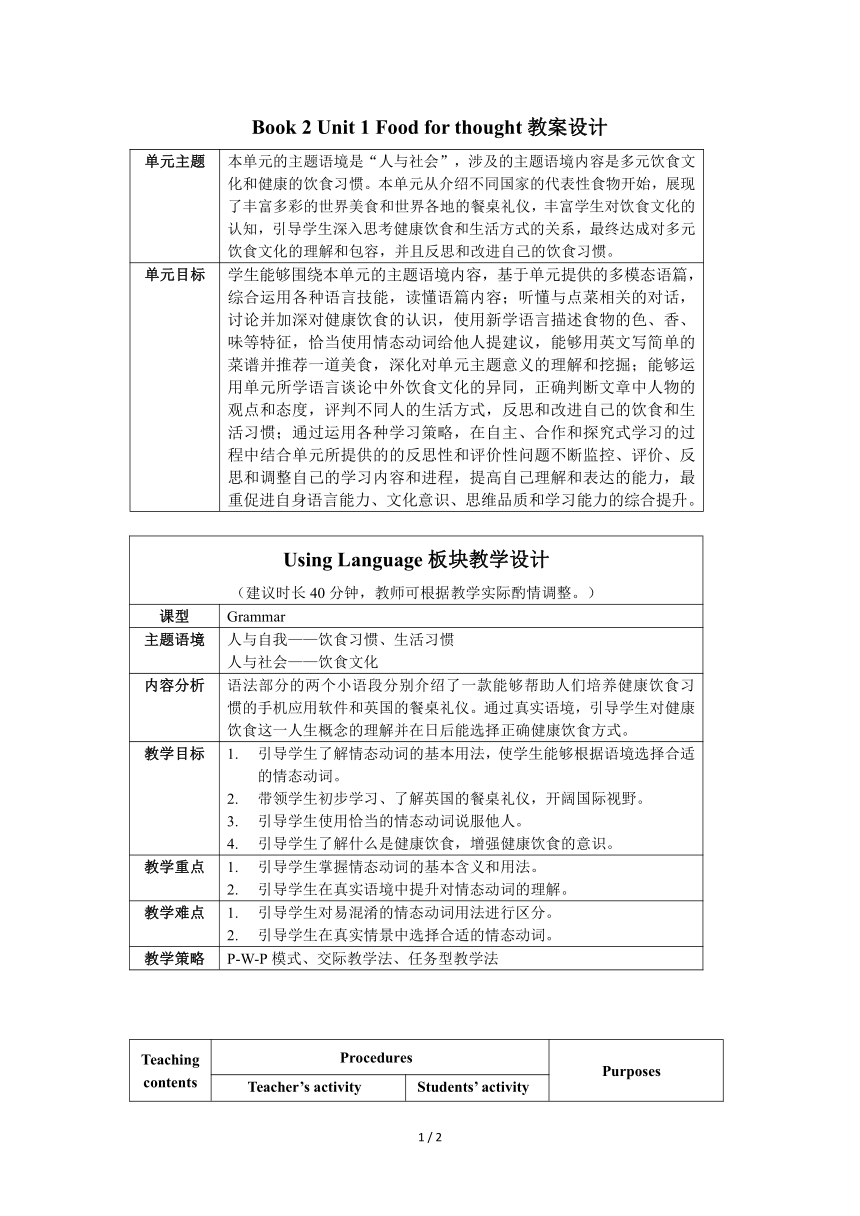外研版(2019)高中英语必修第二册 Unit1Food for thought Using Language 名师教学设计
文档属性
| 名称 | 外研版(2019)高中英语必修第二册 Unit1Food for thought Using Language 名师教学设计 |  | |
| 格式 | docx | ||
| 文件大小 | 25.1KB | ||
| 资源类型 | 教案 | ||
| 版本资源 | 外研版(2019) | ||
| 科目 | 英语 | ||
| 更新时间 | 2023-02-26 16:59:23 | ||
图片预览

文档简介
Book 2 Unit 1 Food for thought教案设计
单元主题 本单元的主题语境是“人与社会”,涉及的主题语境内容是多元饮食文化和健康的饮食习惯。本单元从介绍不同国家的代表性食物开始,展现了丰富多彩的世界美食和世界各地的餐桌礼仪,丰富学生对饮食文化的认知,引导学生深入思考健康饮食和生活方式的关系,最终达成对多元饮食文化的理解和包容,并且反思和改进自己的饮食习惯。
单元目标 学生能够围绕本单元的主题语境内容,基于单元提供的多模态语篇,综合运用各种语言技能,读懂语篇内容;听懂与点菜相关的对话,讨论并加深对健康饮食的认识,使用新学语言描述食物的色、香、味等特征,恰当使用情态动词给他人提建议,能够用英文写简单的菜谱并推荐一道美食,深化对单元主题意义的理解和挖掘;能够运用单元所学语言谈论中外饮食文化的异同,正确判断文章中人物的观点和态度,评判不同人的生活方式,反思和改进自己的饮食和生活习惯;通过运用各种学习策略,在自主、合作和探究式学习的过程中结合单元所提供的的反思性和评价性问题不断监控、评价、反思和调整自己的学习内容和进程,提高自己理解和表达的能力,最重促进自身语言能力、文化意识、思维品质和学习能力的综合提升。
Using Language板块教学设计 (建议时长40分钟,教师可根据教学实际酌情调整。)
课型 Grammar
主题语境 人与自我——饮食习惯、生活习惯 人与社会——饮食文化
内容分析 语法部分的两个小语段分别介绍了一款能够帮助人们培养健康饮食习惯的手机应用软件和英国的餐桌礼仪。通过真实语境,引导学生对健康饮食这一人生概念的理解并在日后能选择正确健康饮食方式。
教学目标 引导学生了解情态动词的基本用法,使学生能够根据语境选择合适的情态动词。 带领学生初步学习、了解英国的餐桌礼仪,开阔国际视野。 引导学生使用恰当的情态动词说服他人。 引导学生了解什么是健康饮食,增强健康饮食的意识。
教学重点 引导学生掌握情态动词的基本含义和用法。 引导学生在真实语境中提升对情态动词的理解。
教学难点 引导学生对易混淆的情态动词用法进行区分。 引导学生在真实情景中选择合适的情态动词。
教学策略 P-W-P模式、交际教学法、任务型教学法
Teaching contents Procedures Purposes
Teacher’s activity Students’ activity
Activity 1 1. Display five sentences from the reading passage. 2. T asks Ss to observe the words in bold. Ss observe the words in bold. Arouse Ss’s interest.
Activity 2 T asks Ss to think about the definition of modal verbs. Ss think about the definition. Cultivate thinking ability.
Activity 3 T asks Ss to figure out the meanings of each modal verb. Ss match the meanings to the modal verbs. Get to know modal verbs’ basic meanings.
Activity 4 1. T explains the usages of ‘be able to’. 2. T asks Ss to think about the difference between ‘be able to’ and ‘can/could’. 3. T summarizes the differences and asks Ss to complete the passage. Ss think about the difference. Ss finish the exercise. 1. Cultivate thinking ability. 2. Enhance Ss understanding of the usages.
Activity 5 T explains the meanings and usages of ‘had better; dare; need’ with the help of varied authentic contexts. Ss observe the usages of modal verbs in authentic sentences. Learn usages of modal verbs through contexts.
Activity 6 T explains the meanings and usages of ‘have to’. T asks students to think about the difference between ‘have to’, ‘must’ and ‘should’. T plays a video and summarizes the differences. Ss think about the difference. Ss watch the video clip. Ss learn the difference from the context. 1. Cultivate thinking ability. 2. Learn usages of modal verbs through contexts.
Activity 7 1. T asks Ss to finish three sets of exercises. 2. T explains the questions that Ss may have difficult dealing with. Ss finish the exercises. Deepen the understanding of what students have learned.
教学反思
在课堂设计方面需要更多关注个体,增强趣味性,吸引学生。 输出部分因为网课缺乏互动,设计略显枯燥,可设计更加新颖一些, 增强互动性。
单元主题 本单元的主题语境是“人与社会”,涉及的主题语境内容是多元饮食文化和健康的饮食习惯。本单元从介绍不同国家的代表性食物开始,展现了丰富多彩的世界美食和世界各地的餐桌礼仪,丰富学生对饮食文化的认知,引导学生深入思考健康饮食和生活方式的关系,最终达成对多元饮食文化的理解和包容,并且反思和改进自己的饮食习惯。
单元目标 学生能够围绕本单元的主题语境内容,基于单元提供的多模态语篇,综合运用各种语言技能,读懂语篇内容;听懂与点菜相关的对话,讨论并加深对健康饮食的认识,使用新学语言描述食物的色、香、味等特征,恰当使用情态动词给他人提建议,能够用英文写简单的菜谱并推荐一道美食,深化对单元主题意义的理解和挖掘;能够运用单元所学语言谈论中外饮食文化的异同,正确判断文章中人物的观点和态度,评判不同人的生活方式,反思和改进自己的饮食和生活习惯;通过运用各种学习策略,在自主、合作和探究式学习的过程中结合单元所提供的的反思性和评价性问题不断监控、评价、反思和调整自己的学习内容和进程,提高自己理解和表达的能力,最重促进自身语言能力、文化意识、思维品质和学习能力的综合提升。
Using Language板块教学设计 (建议时长40分钟,教师可根据教学实际酌情调整。)
课型 Grammar
主题语境 人与自我——饮食习惯、生活习惯 人与社会——饮食文化
内容分析 语法部分的两个小语段分别介绍了一款能够帮助人们培养健康饮食习惯的手机应用软件和英国的餐桌礼仪。通过真实语境,引导学生对健康饮食这一人生概念的理解并在日后能选择正确健康饮食方式。
教学目标 引导学生了解情态动词的基本用法,使学生能够根据语境选择合适的情态动词。 带领学生初步学习、了解英国的餐桌礼仪,开阔国际视野。 引导学生使用恰当的情态动词说服他人。 引导学生了解什么是健康饮食,增强健康饮食的意识。
教学重点 引导学生掌握情态动词的基本含义和用法。 引导学生在真实语境中提升对情态动词的理解。
教学难点 引导学生对易混淆的情态动词用法进行区分。 引导学生在真实情景中选择合适的情态动词。
教学策略 P-W-P模式、交际教学法、任务型教学法
Teaching contents Procedures Purposes
Teacher’s activity Students’ activity
Activity 1 1. Display five sentences from the reading passage. 2. T asks Ss to observe the words in bold. Ss observe the words in bold. Arouse Ss’s interest.
Activity 2 T asks Ss to think about the definition of modal verbs. Ss think about the definition. Cultivate thinking ability.
Activity 3 T asks Ss to figure out the meanings of each modal verb. Ss match the meanings to the modal verbs. Get to know modal verbs’ basic meanings.
Activity 4 1. T explains the usages of ‘be able to’. 2. T asks Ss to think about the difference between ‘be able to’ and ‘can/could’. 3. T summarizes the differences and asks Ss to complete the passage. Ss think about the difference. Ss finish the exercise. 1. Cultivate thinking ability. 2. Enhance Ss understanding of the usages.
Activity 5 T explains the meanings and usages of ‘had better; dare; need’ with the help of varied authentic contexts. Ss observe the usages of modal verbs in authentic sentences. Learn usages of modal verbs through contexts.
Activity 6 T explains the meanings and usages of ‘have to’. T asks students to think about the difference between ‘have to’, ‘must’ and ‘should’. T plays a video and summarizes the differences. Ss think about the difference. Ss watch the video clip. Ss learn the difference from the context. 1. Cultivate thinking ability. 2. Learn usages of modal verbs through contexts.
Activity 7 1. T asks Ss to finish three sets of exercises. 2. T explains the questions that Ss may have difficult dealing with. Ss finish the exercises. Deepen the understanding of what students have learned.
教学反思
在课堂设计方面需要更多关注个体,增强趣味性,吸引学生。 输出部分因为网课缺乏互动,设计略显枯燥,可设计更加新颖一些, 增强互动性。
